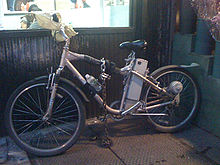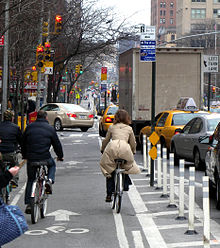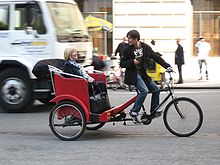- Cycling in New York City
-
New York City offers a mix of favorable cycling conditions — dense urban proximities, short distances and relatively flat terrain — along with significant cycling challenges: congested roadways with stop and go traffic, a sometimes unsympathetic regulatory environment, and streets with heavy pedestrian activity. The city has a large cycling population including utility cyclists such as delivery and messenger services, cycling clubs for recreational cyclists and, increasingly, commuters.[1]
While New York had developed the country's first bike path in 1894,[2] and recent trends place the city "at the forefront of a national trend to make bicycling viable and safe"[2] — competing ideas of urban transportation have led to conflict as well as ongoing efforts to balance the needs of of cyclists, pedestrians and cars.[2]
Contents
History
The bicycle boom of the late 19th century had a strong impact on New York area, and the City of Brooklyn was especially responsive, providing accommodation in Eastern Parkway, Ocean Parkway, and elsewhere. New York didn't produce as many bicycles as other cities, so imported many from elsewhere, including Freehold Township, New Jersey. As a spectator sport, six-day racing was popular and spurred the building of velodromes in suburbs including Washington Heights, Manhattan, and Jersey City, New Jersey. Weekly races were held in suburban roads, including Pelham Parkway, Bronx. The biggest races were in inner city locations, notably at the original Madison Square Garden which had been designed for cycle racing and at the time was located adjacent to Madison Square. The Olympic sport, Madison Racing, is named after cycle races that became popular at Madison Square Gardens.
Several of the middle 20th century parkway projects of Robert Moses included bike paths. However, when more people could afford cars, bicycling declined and the bikeways fell into disrepair. New bridges connecting Queens to The Bronx, or Brooklyn to Staten Island, did not provide for bicycles or pedestrians.
Late in the century, bicycling resurged. A narrow, physically separated bike lane in Sixth Avenue in Midtown Manhattan had little success[3] and was eliminated but bike lanes on major bridges were created, refurbished, or improved, and the New York City Department of Parks and Recreation and other agencies created the Manhattan Waterfront Greenway and other land bikeways.
Utility cycling
 Motorized delivery bike for a restaurant. Chain, lock; plastic bags on handles to protect from winter wind
Motorized delivery bike for a restaurant. Chain, lock; plastic bags on handles to protect from winter wind
 Bike share demo in Times Square
Bike share demo in Times Square
Delivery bikes are commonly used in New York for fast food deliveries over short distances, sometimes using mountain bikes outfitted a lock box (for money), a wide carrier for larger loads such as pizza or other accessories. Electric bicycles are increasingly used for this service, their illegality being sporadically enforced.[4] Bicycle messengers use narrower wheels to carry lighter loads short distances. Specialized cargo bicycles and tricycles carry heavier loads.
Pedicabs became commonplace at the turn of the 21st century, offering novel travel over short distances, including guided tours of Central Park. In April, 2007 the New York City Council voted to limit the number of pedicabs to 325.[5] A court overturned the limit,[6] later regulatory efforts concentrated on requirements for insurance and safety equipment[7] and in April 2011, new legislation tightened parking regulations and capped pedicab licenses at 850.[8]
In 2007 the Department studied the prospects of a bicycle sharing system[9] and announced in 2011 that kiosks would be built for the service to begin in 2012[10] with 10,000 bikes at 600 stations operated by Alta Bikeshare,[11] operators of Capital Bikeshare and similar schemes in other US cities.
Bikeways
Most cycling is in the same lanes as motor traffic, since most streets provide no separate facilities for bicycles. However, bikeways connect most neighborhoods. Those in parks are Greenways, segregated from traffic. The Hudson River Greenway is so heavily used that it requires separation of the bikeway from pedestrians. Other parts of the Manhattan Waterfront Greenway and the Brooklyn-Queens Greenway are less continuously segregated. A Greenway runs through Pelham Bay Park and across the Bronx along Mosholu Parkway to Van Cortlandt Park where it connects to the South County Trailway. Others include foreshoreways along the north shore of Jamaica Bay, the south shores of Little Neck Bay and Flushing Bay and other locations.
Renting, outside Artisans Gate, Central Park Parking under a scanty roof in Long Island City near Pulaski Bridge
Parking under a scanty roof in Long Island City near Pulaski Bridge Bike shop in Bushwick, Brooklyn
Bike shop in Bushwick, Brooklyn
As of February 2009, about 170 miles (260 km) of painted lanes run in streets, and the network is growing.[12] Most street bike lanes are simply marked with paint and signage, and lie between a parking lane and a traffic lane. They are often blocked by trucks unloading and by double parked cars. A few, as in Tillary Street, Brooklyn, replace the parking lane and are separated from motor traffic by concrete barriers. The 8th and 9th Avenue bike lanes in Chelsea, Manhattan were rebuilt in late 2008 to lie between the curb and a new parking lane, and are expected to provide more safety.[13] Similar layouts were used on 1st and 2d Avenues in 2010, and on Columbus Avenue in 2011.
On three Saturdays in August 2008, a route on the East Side of Manhattan from Brooklyn Bridge to 72nd Street along Lafayette Street, Park Avenue and other streets was cleared of motor traffic to allow easy non-motorised use as an experiment called "Summerstreets". [14] It was repeated in 2009 [15] and became an annual event, including August 6, 13 and 20, 2011.
From mid-August 2008, two lanes of Broadway between 42nd Street and Herald Square were transformed into a pedestrian plaza and bike path.[16]
Appreciation of the new bike lanes in streets was not unanimous.[17][18] A group in Park Slope sued in March 2011 to remove a new bike lane.[19]
Recreational
Some parks, including Central Park and Prospect Park, ban or restrict vehicles during certain weekday hours and all weekend to promote bicycling. A company operates bike rental stations in several city parks[20] and Local bike shops also rent them, especially in areas of tourism. Less formal operators work on street corners or out of the back of a truck or in parking garages. Additional services include paid guided tours.
Several organizations, including Five Borough Bicycle Club and Bike New York, conduct tours every weekend. Most are day trips for no fee; some larger or overnight tours require payment. New York Cycle Club and others specialize in fitness and speed. Bicycle track races run most summer weekends in Kissena Park and elsewhere. Road races are held less frequently.
New York City Department of Transportation distributes a free and annually updated bike map[21] through bike shops. The map shows Class 1 physically segregated Greenways in green, and street routes in other colors. It shows the locations and names of bike shops and points of touristic interest. Shops that rent bikes are shown in red.
Commuting
Many New Yorkers live less than a dozen miles or 20 km from their job, and can be seen bicycle commuting over Brooklyn Bridge and along the Hudson or elsewhere in good weather. In 2008 the NYC Department of Transportation released a "screenline count report"[22] suggesting that commuter cycling had more than doubled since the turn of the century.
For mixed-mode commuting most suburban commuter rail stations provide free parking in racks, and some have bicycle lockers for security. Regulations on bicycles on trains vary by railroad and time of day. Bikes are allowed on New York City Subways at all hours, though crowding makes them difficult to handle. Rules against fastening bikes to subway property, including fences around street stairs, are enforced more rigorously than those concerning lampposts and other street furniture. Municipal bicycle stands are installed in many neighborhoods. Most are simple "bike staples" but a few, including one each at the northwest ends of Pulaski Bridge and Union Square are larger, with a roof. More are planned.[23]
Folding bicycles, which often allow parking in a workplace or home closet where there isn't room for a full sized bike, became increasingly popular early in the 21st century.[24] European city bikes from the Netherlands, though lacking this virtue, became a lesser trend in 2008.[25]
In 2009, a local law created by the New York City Council went into effect, requiring commercial buildings with freight elevators to allow employees to transport their bikes on them up to tenant floors. The purpose of the bill was to allow access to indoor storage spaces to encourage commuting by cycling.[26] The City Council also created another local law in 2009 requiring many off-street parking facilities to replace some of their spaces for vehicles with bicycle racks. So far there has been limited demand by cyclists for paid off-street bicycle parking at these garages and lots.[27]
Transportation Alternatives promotes bicycle commuting and bicycle friendly facilities to lessen the impact of cars on urban life.
Laws and rules
A bicycle is considered a vehicle (with the exception that no license is required) in the State of New York and bicyclists follow traffic regulations. Cyclists must move in the direction of traffic, must use hand signals, must only wear headphones in one ear, [28] must not ride on sidewalks, and must use lights at night.[29]
Many bike lanes are in the door zone
Dangers and annoyances
Being doored (to collide with the door of a car unexpectedly opened) is a prominent hazard.[30] Many painted bike lanes run in the door zone and cyclists must be vigilant for motorists and passengers unaware of the law forbidding opening a door into a traffic lane in a way to interfere with traffic, including bicycles. Dooring produces injuries, broken bones and sometimes death.
Approximately 20 cyclists are killed most years, usually by collision with a moving motor vehicle (including those who are knocked under wheels by a door). Some fatality locations are marked by white-painted ghost bikes. Traffic accidents kill approximately 160 pedestrians per year (about half as many as 20 years ago) and a lesser number inside cars.[31]
Activism
Critical Mass Ride and the NYPD
Critical Mass monthly rides in New York have turned into a conflict between the NYPD and bike riders. On 27 August 2004 during the Republican National Convention, more than 400 riders were arrested for 'disrupting traffic'.[32] The arrests, thought to preemptive action against protests during the convention, spawned law suits and courts have ruled that the rides are legal (c.f.[33]). Other rides were also followed by arrests[34], tickets[35] though the NYPD has been content to leave alone.[36]
See also
References
- ^ Fried, Ben (November 9, 2009). "Count on It: NYC Bike Commuting Climbs 26 Percent". streetsblog.org. http://www.streetsblog.org/2009/11/09/count-on-it-nyc-bike-commuting-climbs-26-percent/. Retrieved 2010-02-26.
- ^ a b c Goodman, J. David (November 22, 2010). "Expansion of Bike Lanes in New York Brings Backlash". The New York Times. http://www.nytimes.com/2010/11/23/nyregion/23bicycle.html. "New York has a long relationship with the bicycle, with the first bike path in the country running along Ocean Parkway in Brooklyn as early as 1894."
- ^ "Two Wheelers Take Back Sixth Avenue Bike Lane". Transportation Alternatives. December 30, 1998. http://www.transalt.org/newsroom/releases/1748. Retrieved 2010-02-26.
- ^ Kilgannon, Corey (June 12, 2011). "Battery Power Gives Deliverymen a Boost, at a Cost". The New York Times. http://cityroom.blogs.nytimes.com/2011/06/12/battery-power-gives-deliverymen-a-boost-at-a-cost/. Retrieved 2011-09-22.
- ^ Hicks, Jonathan P. (April 24, 2007). "Pedicab Limit Withstands Mayor’s Veto". The New York Times. http://www.nytimes.com/2007/04/24/nyregion/24council.html. Retrieved 2010-02-26.
- ^ Chan, Sewell (January 17, 2008). "Court Strikes Down Pedicab Licensing Plan". The New York Times. http://cityroom.blogs.nytimes.com/2008/01/17/court-strikes-down-pedicab-licensing-plan/. Retrieved 2010-02-26.
- ^ Grynbaum, Michael M. (June 15, 2009). "Stalled Plan to License Pedicabs Advances". The New York Times. http://www.nytimes.com/2009/06/15/nyregion/15pedicab.html. Retrieved 2010-02-26.
- ^ Zack Stieber, The Epoch Times, 2011 April 28 NY Legislation Caps Pedicabs at 850
- ^ Walker, Dalton (July 10, 2007). "In This Case, It’s O.K. to Take a Bike That’s Not Yours". The New York Times. http://www.nytimes.com/2007/07/10/nyregion/10bike.html. Retrieved 2010-02-26.
- ^ Gay, Jason (June 22, 2011). "The City and Bikes: Rubber Meets Road". The Wall Street Journal. http://online.wsj.com/article/SB10001424052702304070104576399972538343738.html. Retrieved 2011-09-22.
- ^ NYC Dept of Transportation Frequently Asked Questions
- ^ "Bicycle Network and Bicycle Map". New York City Department of Transportation. http://www.nyc.gov/html/dot/html/bicyclists/bikenetwork.shtml. Retrieved 2010-02-26.
- ^ Klein, Melissa (December 14, 2008). "Bloomberg's Big Pedal Push for Bike Lanes". New York Post. http://www.nypost.com/p/news/regional/manhattan/item_0ZV1hhh9velLiVl00OcKUO. Retrieved 2010-02-26.
- ^ Neuman, William; Santos, Fernanda (June 17, 2008). "On 3 Days in August, City Will Try No-Car Zone". The New York Times. http://www.nytimes.com/2008/06/17/nyregion/17closing.html. Retrieved 2010-02-26.
- ^ "Summer Streets". New York City. http://www.nyc.gov/html/dot/summerstreets/html/home/home.shtml. Retrieved 2010-02-26.
- ^ Neuman, William (July 11, 2008). "Closing on Broadway: Two Traffic Lanes". The New York Times. http://www.nytimes.com/2008/07/11/nyregion/11broadway.html. Retrieved 2010-02-26.
- ^ "The City's Bike Obsession". Staten Island Advance. July 4, 2009. http://www.silive.com/opinion/editorials/index.ssf/2009/07/the_citys_bike_obsession.html. Retrieved 2010-02-26.
- ^ Goodman, J. David (November 22, 2010). "Expansion of Bike Lanes in City Brings Backlash". The New York Times. http://www.nytimes.com/2010/11/23/nyregion/23bicycle.html. Retrieved 2011-03-12.
- ^ Robbins, Liz (March 8, 2011). "In Brooklyn, Divided Opinion About a Bike Lane by a Park". The New York Times. http://www.nytimes.com/2011/03/09/nyregion/09bike.html. Retrieved 2011-03-11.
- ^ Bike and Roll New York
- ^ "2009 NYC Cycling Map". New York City Department of City Planning. http://www.nyc.gov/html/dcp/html/bike/cwbm.shtml. Retrieved 2010-02-26.
- ^ "Bicycle Screenline Count". New York City Department of Transportation. http://www.nyc.gov/html/dot/html/bicyclists/nycbicyclescrct.shtml. Retrieved 2010-02-26.
- ^ "Bicycle Information". New York City Department of Transportation. http://www.nyc.gov/html/dot/html/bicyclists/bikemain.shtml. Retrieved 2010-02-26.
- ^ Tuff, Sarah (June 24, 2009). "Gear Test, Folding Bikes". The New York Times. http://www.nytimes.com/slideshow/2009/06/24/style/20090625-physical-slideshow_index.html. Retrieved 2010-02-26.
- ^ Colman, David (April 15, 2009). "Riding the It Factor". The New York Times. http://www.nytimes.com/2009/04/16/fashion/16CODES.html. Retrieved 2010-02-26.
- ^ Goodman, J. David (July 29, 2009). "Council Bill Requires Buildings to Let Bikes In". The New York Times. http://cityroom.blogs.nytimes.com/2009/07/29/council-bill-requires-buildings-to-let-bikes-in/. Retrieved 2010-02-26.
- ^ Goodman, J. David (February 23, 2010). "You Can Park Your Bike, but at What Price?". The New York Times. http://cityroom.blogs.nytimes.com/2010/02/23/you-can-park-your-bike-but-at-what-price/. Retrieved 2010-02-26.
- ^ NYCDoT Cycling safety
- ^ "Bicycling in New York State". New York State Department of Transportation. https://www.nysdot.gov/divisions/operating/opdm/local-programs-bureau/biking. Retrieved 2010-02-26.
- ^ "Get Doored". Word Spy. http://www.wordspy.com/words/getdoored.asp. Retrieved 2010-02-26.
- ^ "Fatalities From Car/Auto Accidents In New York City Dropped To Lowest Level Since Records Started Being Kept In 1910". Levine & Slavit. February 12, 2008. http://www.newyorkinjuries.com/blog/?p=891. Retrieved 2010-02-26.
- ^ Wald, Jonathan (August 29, 2004). "264 arrested in NYC bicycle protest". CNN. http://edition.cnn.com/2004/ALLPOLITICS/08/28/rnc.bike.protest/. Retrieved 2010-02-26.
- ^ http://www.nysd.uscourts.gov/courtweb/pdf/D02NYSC/04-08621.PDF
- ^ "NYPD Attempts To Criminalize Bike Riders". Time's Up. March 28, 2005. http://times-up.org/index.php?page=050328-nypd-attempts. Retrieved 2010-02-26.
- ^ Ferguson, Sarah (February 25, 2006). "Critical Mass: NYPD Carries Smaller Stick This Week". Village Voice. http://blogs.villagevoice.com/runninscared/archives/2006/02/critical_mass_n.php. Retrieved 2010-02-26.
- ^ "Critical Mass April '08 Ride Report: Mass Success". onNYTurf. April 27, 2008. http://www.onnyturf.com/blogs/view_post.php?content_id=19150. Retrieved 2010-02-26.
External links
- 5 Borough Bicycle Club Touring
- New York Cycle Club Speed
- Kissena Cycling Club Track racing
- Fast & fabulous
- New York City bike maps
- Ride the City, a Google Maps API that allows bicycle route planning in the five boroughs.
- Biking Rules! - A New Street Code for NYC Cyclists
- Central Park bicycle rentals
- NYC bike rentals
- Time's Up! Direct Action Environmental Group
- Bike Blog NYC Urban Bike Culture in NYC
Categories:- Cycling in New York City
- Transportation in New York City
- Cycling by city
Wikimedia Foundation. 2010.









